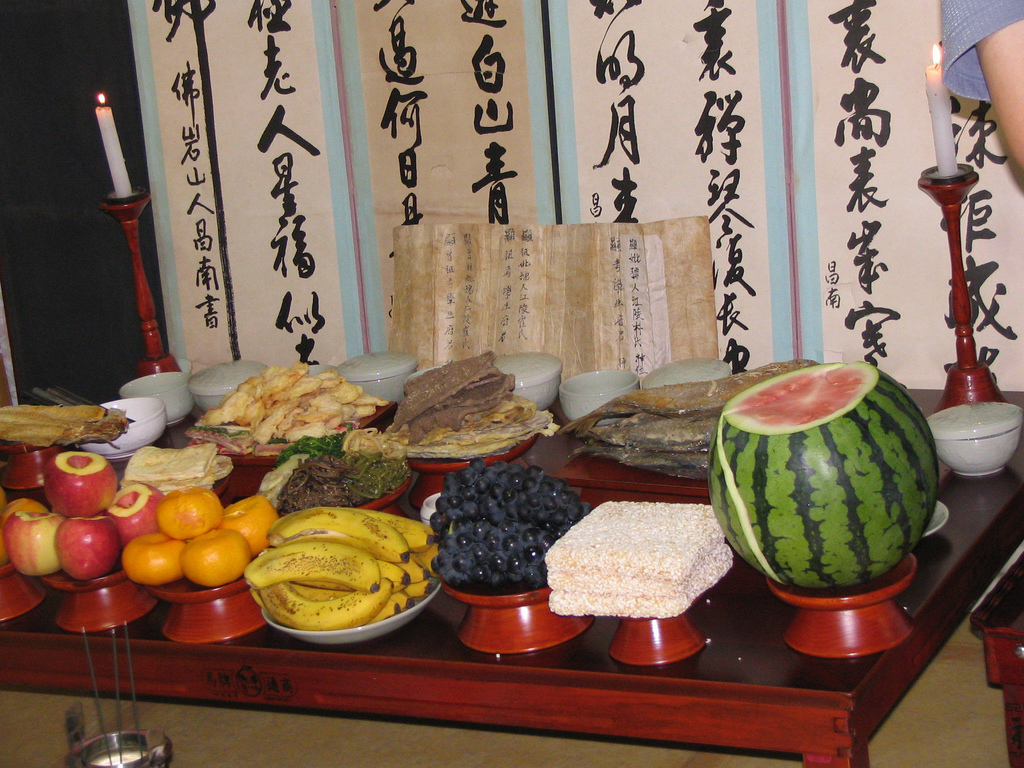|
Jangnye
''Jangnye'' refers to Korean funerary rites. Procedures Generally, ''jangnye'' is performed for three days and nights. If a person is dead, the body will be laid in a coffin after two days and buried during the morning of the third day. Before laying the body in a coffin, a person dealing with the body cleans it and puts on the grave clothes made of hemp. In Korea, it is common for a person in their sixties to prepare grave clothes. Condolers pay a visit to a bereaved family; a chief mourner expresses his sorrow by ''Gok'', which is similar to crying. Usually in the morning of the third day, the bereaved family head for their family burial mountain. They dig the ground, put the coffin in it, and build a mound over the grave. It comes to an end with ''jesa'', which is a Korean traditional memorial service. The ''jangnye'' ceremony is usually held as a burial instead of a cremation. It comes from the Confucian idea that one should not impair the ancestor's bodies but preserve th ... [...More Info...] [...Related Items...] OR: [Wikipedia] [Google] [Baidu] |
Jesa
Jesa (, ) is a ceremony commonly practiced in the East Asian cultural sphere. Jesa functions as a memorial to the ancestors of the participants. Jesa are usually held on the anniversary of the ancestor's death. The majority of Catholics, Buddhists and nonbelievers practice ancestral rites, although Protestants do not. The Catholic ban on ancestral rituals was lifted in 1939, when Pope Pius XII formally recognized ancestral rites as a civil practice (see Chinese Rites controversy). Many Korean Christians, particularly Protestants, no longer practice this rite. Christians generally, and Muslims avoid the rites, and many emigrants avoid the rites Since their origins, Jesa has taken on a certain formality as human civilization has developed, which is sometimes called rituals in Confucianism . Origins in Ancient China Jesa, 祭祀 (corresponding to English: sacrifice (祭), ritual (祀); ) evolved from the ancient Chinese ''sacrifice'' ritual, which refers to the use of strin ... [...More Info...] [...Related Items...] OR: [Wikipedia] [Google] [Baidu] |
Korea
Korea ( ko, 한국, or , ) is a peninsular region in East Asia. Since 1945, it has been divided at or near the 38th parallel, with North Korea (Democratic People's Republic of Korea) comprising its northern half and South Korea (Republic of Korea) comprising its southern half. Korea consists of the Korean Peninsula, Jeju Island, and several minor islands near the peninsula. The peninsula is bordered by China to the northwest and Russia to the northeast. It is separated from Japan to the east by the Korea Strait and the Sea of Japan (East Sea). During the first half of the 1st millennium, Korea was divided between three states, Goguryeo, Baekje, and Silla, together known as the Three Kingdoms of Korea. In the second half of the 1st millennium, Silla defeated and conquered Baekje and Goguryeo, leading to the "Unified Silla" period. Meanwhile, Balhae formed in the north, superseding former Goguryeo. Unified Silla eventually collapsed into three separate states due to ... [...More Info...] [...Related Items...] OR: [Wikipedia] [Google] [Baidu] |
Veneration Of The Dead
The veneration of the dead, including one's ancestors, is based on love and respect for the deceased. In some cultures, it is related to beliefs that the dead have a continued existence, and may possess the ability to influence the fortune of the living. Some groups venerate their direct, familial ancestors. Certain sects and religions, in particular the Eastern Orthodox Church and Roman Catholic Church, venerate saints as intercessors with God; the latter also believes in prayer for departed souls in Purgatory. Other religious groups, however, consider veneration of the dead to be idolatry and a sin. In European, Asian, Oceanian, African and Afro-diasporic cultures, the goal of ancestor veneration is to ensure the ancestors' continued well-being and positive disposition towards the living, and sometimes to ask for special favours or assistance. The social or non-religious function of ancestor veneration is to cultivate kinship values, such as filial piety, family loyalty, an ... [...More Info...] [...Related Items...] OR: [Wikipedia] [Google] [Baidu] |
Death Customs
This article is about death in the different cultures around the world as well as ethical issues relating to death, such as martyrdom, suicide and euthanasia. Death refers to the permanent termination of life-sustaining processes in an organism, i.e. when all biological systems of a human being cease to operate. Death and its spiritual ramifications are debated in every manner all over the world. Most civilizations dispose of their dead with rituals developed through spiritual traditions. Disposal of remains In most cultures, after the last offices have been performed and before the onset of significant decay, relations or friends arrange for ritual disposition of the body, either by destruction, or by preservation, or in a secondary use. In the US, this frequently means either cremation or interment in a tomb. There are various methods of destroying human remains, depending on religious or spiritual beliefs, and upon practical necessity. Cremation is a very old and quite comm ... [...More Info...] [...Related Items...] OR: [Wikipedia] [Google] [Baidu] |


